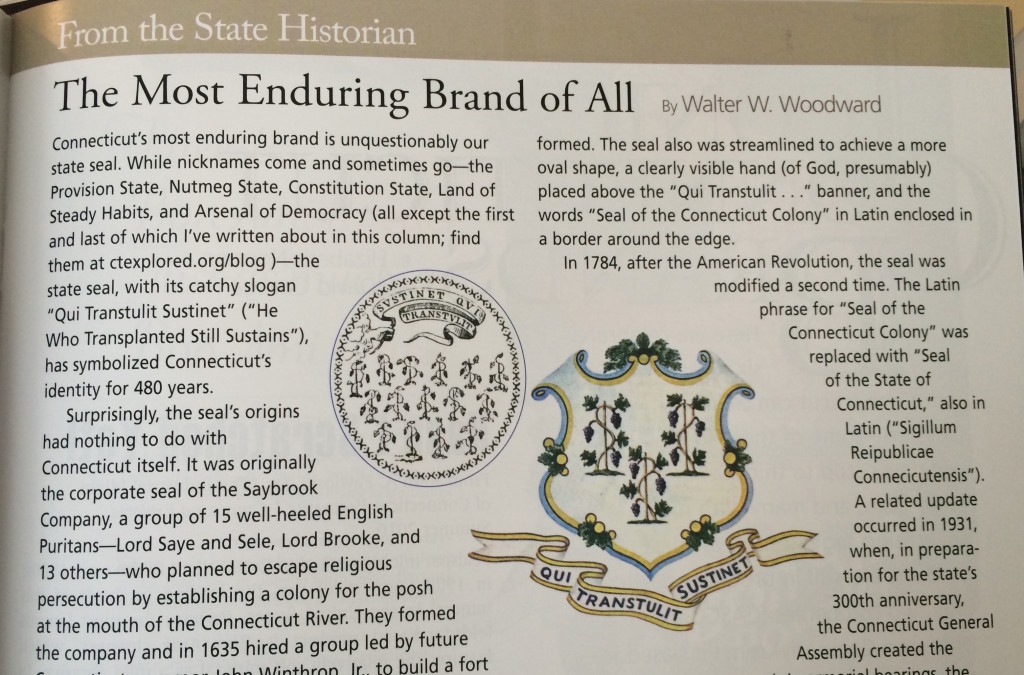By Walter W. Woodward
(c) Connecticut Explored, Inc., Winter 2015-2016
Subscribe/Buy the Issue!
Connecticut’s most enduring brand is unquestionably our state seal. While nicknames come and sometimes go—the Provision State, Nutmeg State, Constitution State, Land of Steady Habits, and Arsenal of Democracy (all except the last of which I’ve written about in this column)—the state seal, with its catchy slogan “Qui Transtulit Sustinet” (“He Who Transplanted Still Sustains”), has symbolized Connecticut’s identity for 380 years.
Surprisingly, the seal’s origins had nothing to do with Connecticut itself. It was originally the co rporate seal of the Saybrook Company, a group of 15 well-heeled English Puritans—Lord Saye and Sele, Lord Brooke, and 13 others—who planned to escape religious persecution by establishing a colony for the posh at the mouth of the Connecticut River. They formed the company and in 1635 hired a group led by future Connecticut governor John Winthrop, Jr., to build a fort and some homes. The company seal had 15 grape plants (one for each investor), and the slogan “He Who Transplanted Still Sustains” served as reminder to them that, once they had emigrated, the God who brought them to Saybrook would sustain them there. The seal acted as a corporate “signature,” making documents containing it official statements of the company.
rporate seal of the Saybrook Company, a group of 15 well-heeled English Puritans—Lord Saye and Sele, Lord Brooke, and 13 others—who planned to escape religious persecution by establishing a colony for the posh at the mouth of the Connecticut River. They formed the company and in 1635 hired a group led by future Connecticut governor John Winthrop, Jr., to build a fort and some homes. The company seal had 15 grape plants (one for each investor), and the slogan “He Who Transplanted Still Sustains” served as reminder to them that, once they had emigrated, the God who brought them to Saybrook would sustain them there. The seal acted as a corporate “signature,” making documents containing it official statements of the company.
The outbreak of the English Civil War and the continuing Anglo-Indian unrest in Connecticut following the 1637 Pequot War put an end to the Saybrook dream in 1643. To recoup some of the company’s losses, agent George Fenwick sold all the company’s assets, including its corporate seal, to the upriver colony of Connecticut. Connecticut, which until then had been a squatter’s plantation without royal sanction or official seal, eagerly embraced the Saybrook seal (and its aura of legitimacy) as its own.
Since that adoption, the seal has only been modified twice. In 1711, the 15 grapevines were reduced to 3, symbolizing the original groups (New Haven, Saybrook, and the Connecticut river towns of Hartford, Windsor, and Wethersfield) from which Connecticut was ultimately formed. The seal also was streamlined to achieve a more oval shape, a clearly visible hand (of God, presumably) placed above the “Qui Transtulit . . .” banner, and the words “Seal of the Connecticut Colony” in Latin enclosed in a border around the edge.
In 1784, after the American Revolution, the seal was modified a second time. The Latin phrase for “Seal of the Connecticut Colony” was replaced with “Seal of the State of Connecticut,” also in Latin (“Sigillum Reipublicae Connecicutensis”). A related update occurred in 1931, when, in preparation for the state’s 300th anniversary, the Connecticut General Assembly created the state armorial bearings, the equivalent of a state coat of arms, with a colorful shield surrounding the seal’s traditional elements (minus the hand of God).
The Office of the Secretary of the State was created under the state’s Fundamental Orders in 1638-1639 and since 1662 has been the official keeper of the state seal. Reproductions of the seal may only be used with the Secretary of the State’s permission, as it is here. For more information about the state’s seal and symbols visit the secretary of the state’s website: ct.gov/sots/cwp/view.asp?a=3188&q=392608.
Walter Woodward is the Connecticut state historian.
Read more of Walt’s columns on our BLOG.
